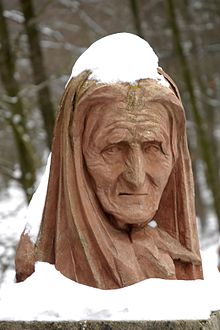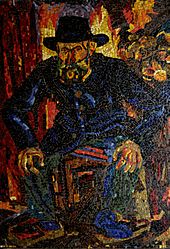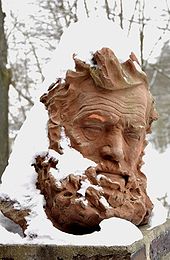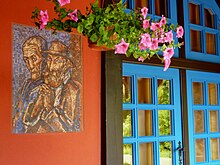Peter August Böckstiegel
Peter August Böckstiegel (born April 7, 1889 in Arrode (today Werther (Westphalia) ), † March 22, 1951 there ) was a German painter , graphic artist and sculptor. He is considered a representative of Westphalian Expressionism .
Life
Peter August Böckstiegel grew up as the fifth of six children in Arrode, which today belongs to Werther (Westphalia) , in a family of small farmers and linen weavers in the simplest of circumstances. His artistic talent was already evident in the elementary school in Werther. In 1903 he began an apprenticeship as a painter and glazier in neighboring Bielefeld .
After successfully completing the journeyman's examination as a painter in 1907, Böckstiegel attended the newly founded craft and applied arts school in Bielefeld , where he met the sculptor Erich Lossie , as well as the painters Victor Tuxhorn , Ernst Sagewka and Heinz Lewerenz . Ludwig Godewols , teacher for drawing from nature at the technical school of the painter's guild in Bielefeld, recognized Böckstegel's artistic talent and encouraged him.
In 1909 he visited the Folkwang Museum in Hagen with Godewols and classmates , where works by Paul Gauguin , Paul Cézanne , Édouard Manet , Auguste Renoir , Auguste Rodin and Anselm Feuerbach were exhibited. In the same year Böckstiegel became a member of the Bielefeld artist group “Rote Erde”.
Böckstiegel's first dated pictures date from 1910. Although the arts and crafts school placed the utmost importance on naturalistic representations and Böckstiegel created academic drawings with classic shades and smudges, he found his own style early on.
In 1912 Böckstiegel visited the Sonderbund exhibition in Cologne with his teacher Godewols and some of his classmates , where he was particularly impressed by Vincent van Gogh .
In the winter semester of 1913, with the help of a private scholarship, he switched to the Academy of Fine Arts in Dresden , where he met Conrad Felixmüller , who was eight years younger, and his sister Hanna Müller († 1988) a little later. His teachers were Oskar Zwintscher and later Otto Gussmann , with whom he later became a master student. In the face of opposition in teaching, in which he above all missed the “youthful passion of the Brücke painters ”, he retained the style he had already developed and, according to Felixmüller, not only influenced his immediate performance and his closeness to nature with his liberating colored power the work of his classmates, but also of his teacher Gussmann. In 1914 one of the most impressive portraits of this time was created, showing Conrad Felixmüller, legs apart and smoking a pipe, in front of wildly flowered wallpaper as a self-confident artist.
At the beginning of 1915 Böckstiegel was called up for military service. On January 1, 1915, he completed the painting Abschied , which shows him and his fiancée Hanna against a bright yellow-orange background. While Böckstiegel is standing upright holding a brush in both hands and in his mouth, Hanna hugs him, her face painted in green and yellow tones. During the war he had to serve as a Landsturmmann , but kept the opportunity to work artistically on the side. From 1916 to 1919 he was used in Russia, Romania and Ukraine. An English ship brought him and his comrades back to Germany from Nykolajew on the Black Sea in March 1919 .
During the war, his contacts with the Dresden scene were not broken off. In 1917 he joined forces with Conrad Felixmüller, Bernhard Kretzschmar , Otto Lange and Constantin von Mitschke-Collande to form the “ Gruppe 1917 ”, whose works have now been shown together with those of the “Brücke” artists.
In 1919 the Dresden Secession Group was founded in 1919 , whose members included Conrad Felixmüller, Otto Dix , Otto Schubert , Gela Foster , Otto Lange, Lasar Segall , Constantin von Mitschke-Collande, Wilhelm Heckrott , Hugo Zehder and, as an external member, Oskar Kokoschka . After his return from the war in March, Böckstiegel joined the group. In July 1919 he married his fiancée Hanna Müller. At the end of the year he left the "Gruppe 1919" together with Felixmüller and Schubert.
His daughter Sonja († 2005) was born in 1920. In the same year the Dresden Academy of Fine Arts granted him the Carlo Torniamentische Reise-Scholarship.
In 1921, instead of the “Rome Prize” , which was also known as the Great Saxon State Prize , which he could not receive as a citizen of Prussia, he received a certificate of honor with the corresponding cash prize. In September 1921, Böckstiegel created the third series of emergency money notes (six 50 Pfennig motifs) with the Pied Piper legend on behalf of the City of Hamelin's magistrate .
His son Vincent († 2007) was born in 1925. In 1929 Böckstiegel began producing his first sculptural works. His mother died in the same year and his father in 1931. With them, Böckstiegel lost the people, of whom he himself wrote that they had become a symbol of humanity in his work as earthly people who tirelessly cultivated their arable land in Arrode with persevering diligence and great love all their lives.
His work experienced a clear turning point in the time of the " Third Reich ". Although Böckstiegel was not banned from exhibiting, his works were declared “ degenerate art ”, dismantled, rejected, confiscated or even destroyed. In 1933 his painting Farmer's Child with Apples was removed from the collections, initially from the Dresden picture gallery and then other works from other museums. In 1937/1938 over 100 of his works were confiscated and, if they could not be sold abroad for foreign currency, they were burned in the courtyard of the Berlin main fire station .
During the bombing of Dresden on 13./14. In February 1945 his studio at Antonsplatz 1 and over a thousand of his works, sculptures, paintings, drawings, printing blocks and etching plates were destroyed. Böckstiegel himself narrowly escaped the bombardment after attempting to outsource parts of his work. He returned with his family to his parents' house in Werther, which had survived the war unscathed. There he went to the expansion of the house to create a new studio and a permanent place to stay.
In 1947 Böckstiegel became the first chairman of the "Westphalian Secession 1945". In the years 1948 and 1949 he portrayed a number of refugees who had come to Westphalia and were housed with the farmers in his neighborhood, mostly under the heading “Silent indictment”. In 1949 Böckstiegel returned to Dresden and took part in the 2nd German Art Exhibition . He received an honorary studio in the Academy in Dresden. In the same year he and his son visited the ruins of their previous residence at Antonsplatz 1. He recovered damaged sculptures and some of the fragments from the buried basement.
A comprehensive solo exhibition began in the Staatliche Kunstsammlungen Dresden in 1950 and was shown in many cities after Böcksteel's death.
On March 22, 1951, Peter August Böckstiegel died in his parents' house in Arrode, which was through and through his artistic work. He is buried in the Evangelical Cemetery in Werther.
Exhibitions
His pictures and works have been shown in a variety of exhibitions in Europe and the USA, including a .:
- 1916: Second exhibition "Dresden Artists"
- 1917: Autumn exhibition in Dresden
- 1918: 46th exhibition "The Expressionist Woodcut"
- 1919: " Dresden Secession Group 1919 ", Emil Richter Gallery
- 1919: Art exhibition Berlin 1919
- 1920: Summer exhibition Free Secession
- 1920: Alice Frank Gallery, Berlin
- 1921: Galerie Alfred Flechtheim, Great Berlin Art Exhibition
- 1921, 1923, 1924, 1925 :: Summer exhibition, Artists' Association Dresden
- 1926: Large watercolor exhibition, Sächsischer Kunstverein , Brühlsche Terrasse, Dresden
- 1927: Graphic exhibition of the German Association of Artists, Dresden City Art Exhibition Building
- 1928: "German Contemporary Art", Norishalle Nuremberg
- 1928 Deutscher Künstlerbund, Kunstverein Hannover
- 1929: III. Great Westphalian Art Exhibition, Münster
- 1929: Exposition Des Peintres Graveurs Allemands Contemporains, Paris
- 1929: “Dresden hand drawings and watercolors of the present”, Nuremberg
- 1931: German Association of Artists, Essen
- 1933: German Association of Artists, Magdeburg
- 1941: Great Westphalian Art Exhibition, City Cultural Office Dortmund
- 1943: “Contemporary German Woodcuts”, Kunstverein Flensburg, August – September 1943
- 1943: Art exhibition Gau Sachsen, Brühlsche Terrassen
- 1947: "2. Exhibition Westphalian Secession 1945 " Karl-Ernst-Osthaus-Museum Hagen,
- 1949: "2. German Art Exhibition “, Stadthalle am Nordplatz, Dresden
- 1950: State Art Collections Dresden
- 1951: Bielefeld Art Association
- 1956: LWL State Museum for Art and Cultural History Münster
- 1969: LWL State Museum for Art and Cultural History Münster / Westfälischer Kunstverein Münster
- 1970: Kunsthalle Bielefeld
- 1975: "Rohlfs Böckstiegel Morgner", Karl-Ernst-Osthaus-Museum Hagen
- 1975: Art Museum Düsseldorf
- 1978/1979: Ettlingen Museum Society
- 1979: “Peter August Böckstiegel Memorial Exhibition”, Berlin
- 1988: “German Expressionism. 1915-1925. The Second Generation ", Modern Art Museum of Fort Worth , Fort Worth, Texas
- 1989: LWL State Museum for Art and Cultural History Münster
- 1990: “Expressionism and Exile. The Ludwig and Rosy Fischer Collection ”, Jewish Museum Frankfurt
- 1999: "The Bunte Collection", Hamburger Kunsthalle
- 2001: “Peter August Böckstiegel. See the work. Discover the artist ”, Gütersloh district building
- 2003: "Face - Mask - Color, Images of Women in the Early 20th Century", Westfälisches Landesmuseum Münster
- 2006: "Working Worlds - Conrad Felixmüller, Peter August Böckstiegel", Dresden City Gallery ,
- 2007: "Working Worlds - Conrad Felixmüller, Peter August Böckstiegel", Kunsthalle Bielefeld (around 45,000 visitors)
- 2009: "Images of People", Wilhelm-Morgner-Haus Soest,
- 2010: "Westphalian Expressionism", Kunsthalle Bielefeld,
- 2012: “Connected to the earth”, House Opherdicke
- 2014: "Peter August Böckstiegel and Conrad Felixmüller, an artist friendship", Ostendorff Gallery, Münster
- 2015: “Peter August Böcksteel's 'family picture'. Searching, finding and restoring “ Stadtmuseum Gütersloh
Some important works by Böckstiegel can be found in large collections and museums: Stedelijk Museum Amsterdam , Düsseldorf, Dresden, Berlin, Hamburg, Stuttgart, LWL State Museum for Art and Cultural History Münster, Kunsthalle Bielefeld and Los Angeles County Museum of Art .
Böckstiegels place in art history today
His early work from 1910 is initially impressionistic arrested. Due to his work from 1913 to 1925, he is one of the most important representatives of late Expressionism. Together with August Macke , Heinrich Campendonk , Wilhelm Morgner , Hermann Stenner and Christian Rohlfs , he is one of the outstanding representatives of Rhenish-Westphalian Expressionism.
What should be emphasized is the variety of artistic forms of expression that he has mastered in a masterly manner, starting with painting and graphics, especially prints, sculptures, decorative works (such as reliefs , mosaics and artistically designed glass windows ) through to the artistic design of his parents' house and home through coloring and carvings.
His love for nature, his lifelong bond with his family, especially his parents, his wife and two children, the neighbors and his parents' house and his Westphalian homeland shape his work.
Böcksteel's works primarily show the rural world. The painter referred to the French Jean-François Millet as his model . Because he also wanted to paint “so real and rustic”. Böckstegel's oeuvre shows close references to van Gogh, not only his self-portrait from 1914, but also various paintings with sunflowers are indications of his intensive examination of the works of Vincent van Gogh .
Prices (selection)
- 1920: Carola-Torniamentischer Reisepreis der Dresdner Akademie der Künste
- 1921: Great Saxon State Prize (Rome Prize) - alternatively in the form of a certificate of honor with a cash prize
Honors and reception
- The Peter-August-Böckstiegel-Haus , the house where he was born in Werther, where he lived and worked in the summer months and which has always been the starting point for his works, has been preserved in its original form and, with its authentic integration into the Westphalian landscape, a cultural one and tourist attraction. With coloring, carvings, mosaics and glass windows, Böckstiegel turned the house into a work of art. In addition to paintings, drawings, watercolors and graphics, there are also sculptures from various creative periods from the artist's estate. The house can be visited by arrangement and as part of public tours.
- After his death, both his wife Hanna and his two children campaigned for the preservation of the house and the works of Peter August Böckstiegel. Maintaining the house and the work as a unit, as a total work of art and making it accessible to the public, was an obligation for her throughout her life. For her contribution to the preservation of the life's work Peter August Böckstiegels the President in 1984 and 2004 Hanna Böckstiegel Sonja and Vincent Böckstiegel awarded the Federal Cross of Merit .
- Sonja and Vincent Böckstiegel established the Peter August Böckstiegel Foundation so that their father’s life's work is preserved, disseminated and presented after their death . To this end, they signed an inheritance contract with the Gütersloh district in 1992 . In doing so, they bequeathed their father's works and the Böckstiegel house to the Gütersloh district. At the same time, the district of Gütersloh committed itself to the Böckstiegel siblings to establish the Peter August Böckstiegel Foundation after the inheritance. As part of the preparations for the establishment of the foundation, the district of Gütersloh made clear the aim of adding a museum to the Peter-August-Böckstiegel-Haus. The Peter August Böckstiegel Foundation was established on December 18, 2008. Your task is to preserve the Böckstiegel-Haus and the artist's life's work, to look after the estate artistically and to make it accessible to the public.
- On August 31, 2018, after a two-year construction period, the Böckstiegel Museum opened on the old orchard in front of the Böckiegelhaus. In addition to exhibitions on the work of Peter August Böckstiegel, the museum, which costs 3.8 million euros, will also show other expressionist temporary exhibitions by local artists. It is supported by many volunteers.
- The PA Böckstiegel Freundeskreis eV was founded in 1993 on the basis of a circle of friends around the Böckstiegel siblings. Its purpose is to look after the memory of the life and work of the artist as well as to preserve and spread his work. In addition to many other activities, the association had the catalog raisonné drawn up and, together with the Kunsthalle Bielefeld, enabled exhibitions.
- The PA Böckstiegel Freundeskreis eV awarded the "Peter August Böckstiegel Prize" for the first time in 2007. The award is aimed at visual artists under the age of 40 from the art genres of painting, graphics and sculpture, whose place of birth, residence or work is in East Westphalia-Lippe . The prize is endowed with 6,000 euros; the winner will also be shown an exhibition in the Kunsthalle Bielefeld. The first prize winner was Nicole Schuck, who was born in Herford, from Berlin.
- His hometown today presents itself under the slogan "Böckstiegel-Stadt Werther". The “Böckstiegel -pfad” leads along Schloßstraße through Werther (Westphalia) . Using the 15 signposted stations, you can learn about life and work in the landscape in which he looked for his motifs during his lifetime. The local comprehensive school is also named after him.
- During his painting and glazing apprenticeship, Böckstiegel had to walk the route from Werther to Bielefeld every day. This is symbolically linked to the “Böckstiegel-Lauf” as a running event . The organizers are the Werther Advertising Association together with the PA Böckstiegel Freundeskreis eV The sporting organization is the LC Solbad Ravensberg.
- In Bielefeld and Dresden streets are named after Böckstiegel.
Museum Peter August Böckstiegel
In 2014, the district of Gütersloh approved 2 million euros as a financial basis for the construction of a museum on the property of the Künstlerhaus in Schloßstraße 109/111 in Werther. Thanks to donations from Gütersloh and Westphalia, the originally planned area could be doubled. The groundbreaking ceremony took place on April 7, 2016 and the topping-out ceremony on March 3, 2017. The building, a cube clad with shell limestone slabs and provided with incisions, was completed in March 2018. This was followed by the exterior work with the creation of an orchard meadow in front of the museum, a “green classroom” and seating. On August 31, 2018, the Peter August Böckstiegel Museum opened its doors. The museum is located on the meadow in front of the Künstlerhaus and is open all year round.
literature
- Nikolaus Nadrag, David Riedel (eds.): Peter August Böckstiegel. Expressionism seeks the soul. Works from 1911 to 1951. Bielefeld 2016.
- Theodor Helmert-Corvey, David Riedel (eds.): Peter August Böckstiegel - "Experienced and viewed". Unknown works on paper. Exhibition cat. Herford Art Association, Tönen 2014.
- David Riedel (ed.): Peter August Böckstiegel: The paintings. 1910-1951. Munich 2014.
- Klaus Kösters (ed.): Peter August Böckstiegel, the farmers and the art. Munster 2009.
- Jutta Hülsewig-Johnen (ed.): Conrad Felixmüller - Peter August Böckstiegel: Working worlds. Exhibition cat. Dresden City Gallery, Bielefeld Art Gallery, Cologne 2006.
- Vita von Wedel, edited by P.-A.-Böckstiegel-Freundeskreis e. V .: Peter August Böckstiegel: Catalog raisonné of the plastic and decorative works. Bielefeld 2003.
- Vita von Wedel, edited by P.-A.-Böckstiegel-Freundeskreis e. V .: Peter August Böckstiegel: Catalog raisonné of pastels, watercolors and drawings. Bielefeld 2001.
- Thomas Matuszak: “I am born to suffer”: Peter August Böckstiegel, the war and the figure of Salome. In: Low German contributions to art history, Vol. 38. 1999, pp. 321–330.
- Thomas Matuszak, State Lindenau Museum: Peter August Böckstiegel, the graphic work: 1889–1951. 2nd edition Altenburg 1998.
- Jutta Hülsewig-Johnen, Vita von Wedel (ed.): Peter August Böckstiegel: People and Landscapes. Monograph and catalog raisonné. Cologne 1997.
- Ernst-Gerhard Güse (Red.): The Peter-August-Böckstiegel-Haus in Arrode. Gütersloh 1993.
- Gert Claussnitzer: Peter August Böckstiegel: small artist monograph. In: The studio. Vol. 4. Dresden 1991.
- Ernst-Gerhard Güse (ed.): PA Böckstiegel. Exhibition cat. Westphalian State Museum for Art a. Cultural history of Münster, Münster 1989.
- Vita von Wedel: Peter August Böckstiegel: 1889–1951: descriptive catalog raisonné of the oil paintings. Diss. Univ. Hamburg, 1986.
- Ernest W. Uthemann: Peter August Böckstiegel. Picture books of the Westphalian State Museum for Art and Cultural History. No. 22, 1984.
Web links
- Literature by and about Peter August Böckstiegel in the catalog of the German National Library
- Museum Peter August Böckstiegel
- PA Böckstiegel Freundeskreis e. V.
- Böckstiegel run
Individual evidence
- ↑ Schrock No. 13-18; UEG Schrock: History of the Hamelin emergency money 1916 to 1948. Bremen 1987.
- ^ Ostendorff Gallery
- ↑ City Museum Gütersloh: Peter August Böckstiegels "Familienbild". Searching, finding and restoring , accessed on May 12, 2015.
- ^ Peter August Böckstiegel Foundation: Museum Peter August Böckstiegel. In: Museum PAB. Peter-August-Böckstiegel-Stiftung, 2018, accessed on November 27, 2019 (German).
| personal data | |
|---|---|
| SURNAME | Böckstiegel, Peter August |
| BRIEF DESCRIPTION | German painter |
| DATE OF BIRTH | April 7, 1889 |
| PLACE OF BIRTH | Arrode, Werther |
| DATE OF DEATH | March 22, 1951 |
| Place of death | Arrode, Werther |








